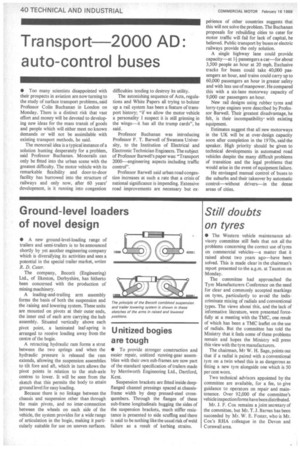Transport 2000 AD: auto-control buses
Page 42

If you've noticed an error in this article please click here to report it so we can fix it.
• Too many scientists disappointed with their prospects in aviation are now turning to the study of surface transport problems, said Professor Colin Buchanan in London on Monday. There is a distinct risk that vast effort and money will be devoted to developing new ideas for the mass transit of goods and people which will either meet no known demands or will not be assimilable with existing transport methods, he said.
The monorail idea is a typical instance of a solution hunting desperately for a problem, said Professor Buchanan. Monorails can only be fitted into the urban scene with the greatest difficulty. The motor vehicle with its remarkable flexibility and door-to-door facility has burrowed into the structure of railways and only now, after 60 years' development, is it running into congestion difficulties tending to destroy its utility.
The astonishing sequence of Acts, regulations and White Papers all trying to bolster up a rail system has been a feature of transport history; "if we allow the motor vehicle a personality I suspect it is still grinning in the wings—it has all the trump cards", he said.
Professor Buchanan was introducing Professor F. T. Barwell of Swansea University, to the Institution of Electrical and Electronic Technician Engineers. The subject of Professor Barwell's paper was: "Transport 2000 engineering aspects including traffic control".
Professor Barwell said urban road congestion increases at such a rate that a crisis of national significance is impending. Extensive road improvements are necessary but ex perience of other countries suggests that this will not solve the problem. The Buchanan proposals for rebuilding cities to cater for motor traffic will fail for lack of capital, he believed. Public transport by buses or electric railways provide the only solution.
A single highway lane could provide capacity—at 1-1passengers a car—for about 3,500 people an hour at 20 mph. Exclusive tracks for buses could take 40,000 passengers an hour, and trains could carry up to 60,000 passengers an hour in greater safety and with less use of manpower. He compared this with a six-lane motorway capacity of 9,000 car passengers an hour.
New rail designs using rubber tyres and lorry-type engines rere described by Professor Barwell. Their greatest disadvantage, he felt, is their incompatibility. with existing equipment.
Estimates suggest that all new motorways in the UK will be at over-design capacity soon after completion in the 1970s, said the speaker. High priority should be given to technical developments in automated road vehicles despite the many difficult problems of transition and the legal problems that would arise in the event of equipment failure.
He envisaged manual control of buses to the suburbs and their takeover by automatic control—without drivers—in the dense areas of cities.




















































































































